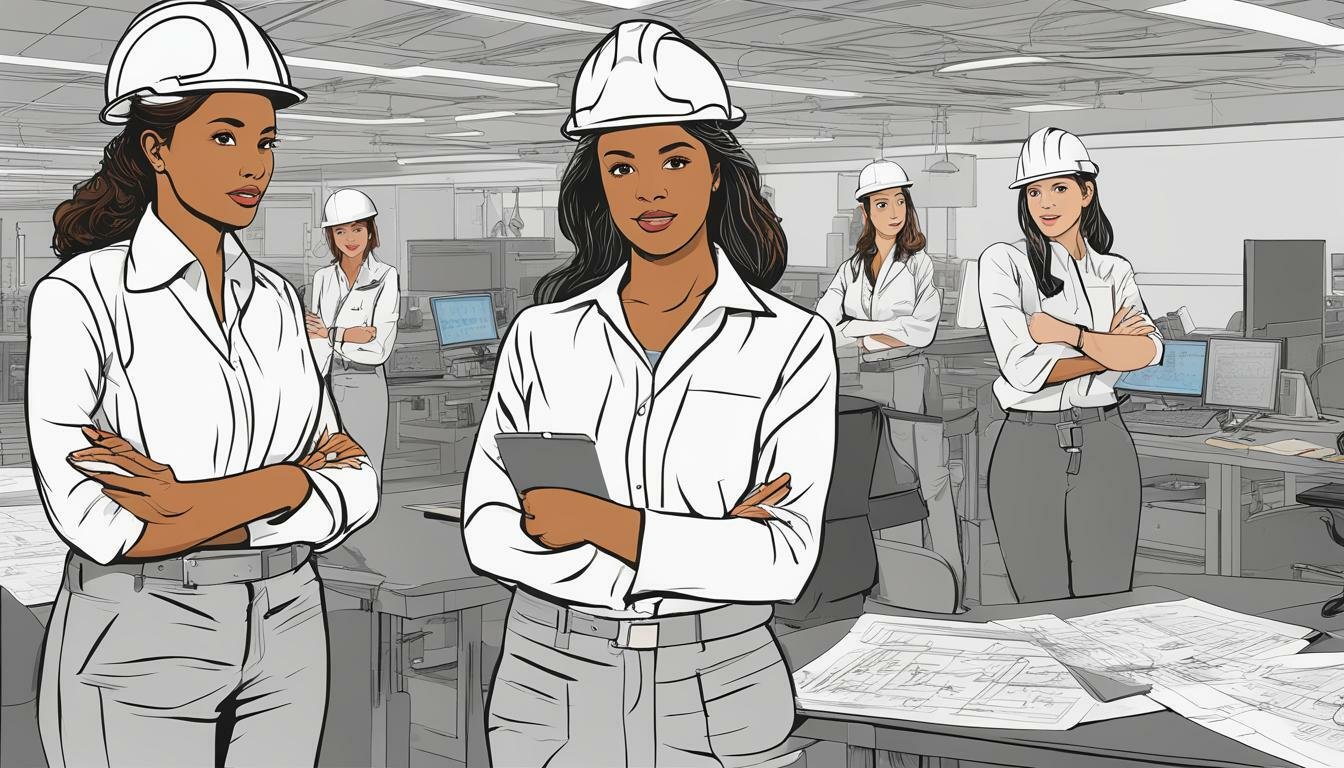Women engineers have long been underrepresented in the field, facing significant challenges and barriers in their careers. From gender bias to workplace discrimination, these obstacles can have a profound impact on women’s opportunities for professional growth and success. It is essential to address these issues and promote workplace equity for all engineers, regardless of gender.
Key Takeaways
- Women engineers face numerous challenges in the workplace, including gender bias and discrimination.
- Addressing these issues is crucial for promoting workplace equity and creating a more inclusive field.
- Initiatives aimed at supporting women engineers and fostering diversity can help break down barriers and promote professional growth.
Women in Engineering: Breaking Barriers and Overcoming Gender Bias
The underrepresentation of women in STEM fields, including engineering, has been an ongoing issue. Historically, women were discouraged from pursuing engineering careers, and gender bias in the industry has made it difficult for women to advance and succeed. However, progress has been made in breaking down these barriers.
According to a report by the National Science Foundation, the percentage of bachelor’s degrees in engineering awarded to women has nearly doubled since 1995, from 17.1% to 33.7% in 2019. This increase in female representation demonstrates that efforts to encourage more women to pursue engineering careers have been successful.
Despite this progress, gender bias in engineering still exists. Women engineers face obstacles such as discrimination, lack of mentorship opportunities, and unconscious bias. These factors can hinder their career growth and advancement.
It is important to continue promoting diversity and inclusion in engineering and STEM fields. Encouraging more women to pursue engineering careers and providing support for their professional growth will benefit the entire industry. A diverse workforce brings unique perspectives and experiences that can drive innovation and lead to better outcomes.

Women in Engineering: Breaking Barriers and Overcoming Gender Bias
“We need to create a culture where young women are encouraged to pursue engineering and feel supported in their career journey.”
Initiatives such as Girls Who Code and Women in Engineering Programs are working to break down barriers and encourage more women to enter the field. Providing mentorship opportunities, promoting female role models in engineering, and fostering a culture of inclusivity can help women engineers overcome gender bias and succeed in their careers.
As the engineering industry continues to evolve, it is essential to prioritize workplace equity and ensure that women are given equal opportunities to succeed. By breaking barriers and promoting diversity, engineering can become a more inclusive and innovative field for all.
Navigating Workplace Discrimination: Overcoming Gender Stereotypes in Engineering
Women engineers face a multitude of discrimination in the workplace, including harmful gender stereotypes. These stereotypes not only limit career opportunities for women but also create a hostile work environment.
Gender stereotypes portray women as less competent, less capable of leadership roles, and less interested in technical work. These harmful stereotypes create barriers to career development for women in engineering.
Challenging these stereotypes is crucial for achieving workplace equity. Women must be given equal opportunities to showcase their skills and excel in engineering roles. Employers can support women engineers by providing mentorship, professional development opportunities, and addressing unconscious bias in the hiring process.
It is also important for women to advocate for themselves and challenge gender stereotypes in the workplace. By speaking up and pushing back against harmful behaviour, women can help to foster a more inclusive and supportive work environment.
| Strategies for overcoming gender stereotypes: |
| Challenge negative assumptions and biases |
| Advocate for yourself and other women engineers |
| Seek out role models and mentors |
| Learn new skills and take on challenging projects |
| Encourage others to speak up against harmful behaviour |
By breaking down gender stereotypes and fostering inclusion in the workplace, we can create a more diverse and innovative engineering field.

Breaking the Glass Ceiling: Advancing Women in Engineering
The engineering field has long been viewed as a male-dominated industry, with women facing significant challenges in career advancement. The existence of the “glass ceiling” – an invisible barrier that blocks women from reaching the highest levels of leadership – remains a persistent issue.
Despite progress made in recent years, women continue to be underrepresented in engineering leadership positions. According to a report by EngineeringUK, just 12% of engineers in the UK are women, with only 6% of female engineers in technical and engineering roles.
Breaking the glass ceiling in engineering requires significant effort and support. Initiatives aimed at advancing women in engineering and promoting leadership opportunities have been established in recent years, including mentorship programmes and networking events for women engineers. In addition, some companies have implemented diversity and inclusion policies to support underrepresented groups and create more opportunities for career advancement.
One such initiative is the Women in Engineering Society (WES), a UK-based organisation that supports and promotes women in engineering. WES offers a range of programmes and initiatives aimed at advancing women in engineering, including a mentoring programme, a career development conference, and a funding scheme for women pursuing engineering degrees.
Another example is the Women in Science and Engineering (WISE) campaign, which focuses on encouraging girls and women to pursue careers in science, technology, engineering, and maths (STEM). The campaign aims to increase the number of women in STEM and promote diversity and inclusion in the industry.
These initiatives play a crucial role in supporting women engineers and promoting diversity in the engineering field. However, more work needs to be done to address the underlying issues that contribute to the glass ceiling and promote gender equity in engineering.

“The glass ceiling in engineering requires significant effort and support. Initiatives aimed at advancing women in engineering and promoting leadership opportunities have been established in recent years, including mentorship programmes and networking events for women engineers.”
One key challenge is the need for cultural and systemic change within the industry. This requires addressing issues such as bias and stereotypes, promoting greater diversity and inclusion within engineering teams, and establishing more family-friendly policies to support a better work-life balance for women engineers.
Efforts to break the glass ceiling and advance women in engineering must also be coupled with a commitment to achieving equal pay. Despite the progress made in recent years, the gender pay gap in engineering remains a significant issue, with women engineers earning less than their male counterparts for comparable roles.
In conclusion, breaking the glass ceiling in engineering requires concerted effort and support from all sectors of the industry. Initiatives aimed at advancing women in engineering and promoting diversity and inclusion can help address the underlying issues that contribute to gender inequity in the field. However, continued efforts are needed to achieve true gender equity and make the engineering industry a more inclusive and supportive environment for women engineers.
Bridging the Gender Pay Gap in Engineering
Despite progress in promoting workplace equity, the gender pay gap remains a persistent issue in the engineering industry. Women engineers still earn less than their male counterparts, with the gap widening at higher levels of seniority. This disparity not only affects women’s financial security but also hinders their career progression and overall job satisfaction.
The factors contributing to the gender pay gap in engineering are complex and multifaceted. Research suggests that implicit bias, lack of transparency in salary negotiations, and occupational segregation are among the primary culprits. Additionally, women may be penalized for taking time off for caregiving responsibilities or pursuing flexible work arrangements.
Addressing the gender pay gap in engineering requires a concerted effort from all stakeholders, including employers, policymakers, and individual employees. Companies can promote pay transparency, eliminate bias in recruitment and promotion processes, and offer family-friendly policies such as parental leave and flexible schedules.
Policymakers can also play a role in promoting pay equity by enforcing anti-discrimination laws and providing incentives for companies that adopt gender-neutral pay practices. Additionally, professional organizations and advocacy groups can offer resources and support for women engineers navigating the pay gap and advancing their careers.
Ultimately, closing the gender pay gap in engineering is vital to achieving workplace equity and promoting diversity and inclusion in the industry. By valuing and compensating all engineers fairly, regardless of gender, the industry can attract and retain top talent and drive innovation.

Achieving Work-Life Balance: A Struggle for Women Engineers
Balancing work and personal life can be challenging for anyone, but it can be particularly difficult for women in engineering. Despite advances in workplace equity, women still carry the bulk of the responsibilities when it comes to caregiving and household management.
According to a study by the Society of Women Engineers, women engineers face more obstacles than their male colleagues when it comes to achieving work-life balance. These challenges can include a lack of flexible work arrangements, limited access to childcare, and long hours that make it difficult to balance work and family commitments.
To address these challenges, employers can take steps to support women engineers in achieving work-life balance. This can include offering flexible work arrangements, such as remote work or flexible hours, providing on-site childcare, and implementing policies that support work-life integration.

Women engineers can also take steps to prioritize work-life balance. This can involve setting clear boundaries between work and home life, practicing self-care, and seeking out support from colleagues and family members.
Achieving work-life balance is not only critical for women engineers’ wellbeing, but also for the success of the engineering industry as a whole. When employees are able to balance their work and personal responsibilities, they are more productive, engaged, and committed to their jobs. By prioritizing work-life balance for women engineers, employers can create a more inclusive and supportive workplace that benefits everyone.
Fostering Inclusion: Encouraging Diversity in Engineering
Despite progress towards gender equity, women remain underrepresented in engineering, facing numerous challenges in the workplace. To promote diversity and support inclusion, initiatives must be implemented to encourage more women to pursue careers in engineering and create a more welcoming industry for all.
One initiative that aims to attract and retain more women in engineering is providing mentoring and networking opportunities. By connecting women engineers with role models and peers, they can gain valuable insights, skills and support to advance their careers. Additionally, companies can implement flexible work arrangements to accommodate the unique needs of women in engineering, such as parental leave and remote work options.
An inclusive and diverse workforce in engineering can drive innovation, offer fresh perspectives, and spur creative problem-solving. To achieve this, efforts to improve recruitment and retention practices must be prioritized. This includes reviewing job descriptions, encouraging diverse interview panels, and offering unconscious bias training to decision-makers.
Education and outreach initiatives can also be effective in attracting women to the engineering field. By providing access to information and resources, women can learn more about the diverse range of career opportunities available in engineering and gain the confidence to pursue them. Outreach programs can also target underrepresented groups, providing them with the skills and support necessary to succeed in engineering.
Ultimately, to encourage diversity and foster inclusion in engineering, a collaborative effort is needed from educators, industry leaders, and policy-makers. By working together to address the challenges faced by women engineers, we can create a more equitable and supportive environment for all.

Conclusion
Women engineers face a range of challenges in the workplace, from gender bias and stereotypes to the glass ceiling and gender pay gap. It is important to address these issues for a more equitable and inclusive field that attracts and retains top talent.
Despite the obstacles, progress has been made in breaking down barriers and promoting career advancement for women in engineering. However, there is still a long way to go in achieving true workplace equity.
Efforts must continue to be made to foster an environment that supports diversity and inclusion. This includes initiatives aimed at attracting and retaining more women engineers, as well as promoting work-life balance and leadership opportunities.
By working together to address these challenges, the engineering industry can become a more inclusive and supportive field that drives innovation and advances societal progress. Let us continue to strive towards a brighter future for women engineers and the engineering industry as a whole.
FAQ
Q: What are some of the challenges faced by women engineers?
A: Women engineers often encounter gender bias, workplace discrimination, and the glass ceiling that hinders their career advancement.
Q: How can gender stereotypes in engineering be overcome?
A: Challenging and overcoming gender stereotypes in engineering can be achieved through creating awareness, promoting inclusive policies, and providing mentorship and support for women engineers.
Q: How can the gender pay gap in engineering be addressed?
A: Closing the gender pay gap in engineering requires equal pay policies, transparency in salary negotiations, and promoting women’s leadership roles.
Q: What initiatives support the professional growth of women engineers?
A: There are various initiatives and programs that support the professional growth of women engineers, including mentorship programs, networking opportunities, and leadership development initiatives.
Q: How can work-life balance be achieved for women engineers?
A: Achieving work-life balance for women engineers requires flexible work arrangements, supportive workplace policies, and an understanding and inclusive work culture.
Q: Why is diversity important in engineering?
A: Diversity in engineering leads to increased innovation, creativity, and problem-solving abilities. It also helps in overcoming biases and creating a more inclusive and productive work environment.
























Post comments (0)